With many members as well as others in the horticulture industry taking a no doubt well-earned summer holiday during August this month's Newsletter is inevitably a bit shorter than usual. Amongst those away is Alison Foster who is currently working in a botanic garden on the island garden, Lokrum, off the coast of Croatia (about which we will hope to hear more in a later newsletter) so we do not have her usual Medicinal Plant of the Month. Nevertheless we have found a Plant of the Month to feature.
September is the month for our Annual General Meeting which will be held at Belgrave Square on 24 September. As well as the formal meeting we will have an intriguing talk by David Whalley and Alison Foster entitled 'Magic Murder and Plant Potions'. Please come along, enjoy the talks and give us your views on the Group's activities.
Editor
Cantelo Nurseries
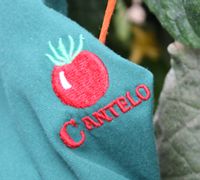
Our leader and guide for the day, Tony Girard, supplied blue plastic 'bootees' for all to wear prior to entering the first glasshouse. This, an old glasshouse, contained normal long cucumbers, ridge cucumbers and short 'mini' cucumbers all being grown on a low input organic system.
The nursery is obliged to provide organic produce as part of their supply contract but it is difficult to make it economic. By utilising these old glasshouses which had already 'paid for themselves' it was possible to keep costs to a minimum and accept that some crop failures were inevitable. In last year's damp summer, blight had wiped out the crop.
The plants were being grown in 'unsterilized' soil which had been improved with composted bark and top-dressed with pelleted fertilizer based on poultry manure. An organic liquid feed was being used but, to avoid the usual problems such feeds give with blocked irrigation lines, several flushes of plain water were supplied between feeds. Perhaps the one exception to the low-cost approach was the use of more expensive grafted plants to reduce root disease problems. They aimed to clear the house in mid-August to allow the high late summer temperatures (in 2010?) to provide a level of heat sterilization.
Mildew resistant varieties were used leaving Botrytis as the main fungal problem. Red spider was well controlled by predators but aphids still proved difficult. Of the options available, Pyrethrum, upset natural predators, leaving the 'insecticidal soap' Savona as the only alternative.
We moved on to a younger cucumber crop not yet in production but intended to maintain the supply through to November. Then to tomatoes where the vines were laden with fruit partly because some were being harvested as full trusses and partly because the hot weather had caused more fruit to ripen than the customers could take. Nevertheless the nurseries army of bumble bees was busy flying back and forth around us pollinating the flowers to produce next month's crop.
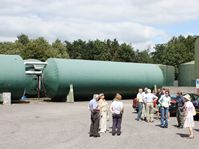
The eleven hectares of glass was all being cropped with peppers, half grown organically and half conventionally. Of particular interest was the suspended gutter growing system (pictured right) that was being used for the conventional crop. The rockwool growing slabs were placed on a platform suspended from the roof trusses of the glasshouses. The sides of the platform were shaped to provide gutters to collect the runoff from the slabs and a slight slope along the length of the gutter enabled this to be collected for recycling.
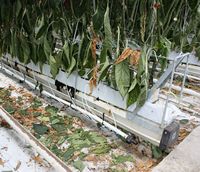
The main problems on peppers were aphids followed by red spider, thrips and leaf hoppers. Whitefly was not too serious. Aphids caused the biggest headache with 3-4 species being involved. To combat these parasitic wasps were used in the spring and early summer but by July they started to succumb to a hyperparasite so they resorted to the predatory midge (Aphidoletes) for control.
This visit was aimed to examine not just the growing systems but to see the methods of pest and disease control in practice. Tony plans to organize a discussion day later in the year to go into the more theoretical aspects surrounding the selection of biological control agents and their use.
Sue and Peter Grimbly
Horticulture Group
Plant of the Month
Cornflower (Centaurea cyanus), Compositae
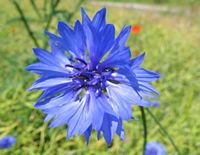
In recent years it has become an essential constituent of annual wild flower mixtures but these still represent only a small and ephemeral area. Interest in it has been heightened more recently because it has extra-floral nectaries. These organs, frequently located on the leaf petiole, secrete a similar sugary sap containing around 95% sugars, mainly fructose, sucrose. They are found on many plants and attract insects, chiefly ants which help the plant by attacking pests. The nectar can also provide food (energy) for bees, hoverflies, lacewings, parasitoid wasps and other pest natural enemies.
Research literature suggests that cornflower is unlikely to support pest insects so it is a good plant to include in field margins around crops. Many of the nectar feeding, pest-eating insects that are attracted to the flowers also pollinate crops and increase yields.
Sue and Peter Grimbly
Horticulture Group
Horticulture Industry News
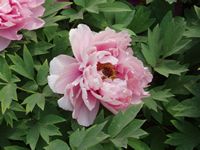
Researchers from the Yale University School of Medicine revealed that peony (Paeonia sp. Photo by Fanghong) could soon provide fresh hope to cancer sufferers. It could help relieve the side-effects of chemotherapy like nausea, vomiting, diarrhoea, stomach ache, and weight loss. When provided in combination with three other plants it also reduces the growth of tumours. The research used a preparation based on centuries-old Chinese traditional medicines made up with peony, liquorice (Glycyrrhiza glabra), extracts of date (Phoenix dactylifera) and extracts of the skullcap plant (Scutellaria lateriflora). The amalgamation of chemotherapy and herbs symbolizes a marriage of Eastern and Western approaches to the treatment of cancer, said lead researcher Dr Yung-Chi Cheng.
Rosemary Collier to head Crop Centre
The University of Warwick has announced that Dr Rosemary Collier is to take up the role of Research Director of the University's Crop Centre in October. The centre, which will continue some of the work of Warwick HRI will have a range of expertise including: crop breeding, plant pathology, agronomy, crop nutrition and environmental research. The Genetic Resources Unit will also be part of the Crop Centre. This unit has a remit for collection, conservation, characterization, documentation and research for a range of vegetable crops and their wild relative. More
Twitter, Facebook and the iPhone - in the UK....
Pat Fitzgerald of Fitzgerald Nurseries took to the web to conduct a year long experiment on the use of social networking. He linked Twitter, Facebook and Blogger accounts to his website and contacts came in thick and fast. Keeping up to date with all the tweets and posts took time but the iPhone came in and it became easier particularly with Twitter and Facebook. He found that he needed a blog to give information about new products every two or three weeks and use Twitter and Facebook to advertise what was in the blog. Fitzgerald is keen to emphasise the importance of real-world relationships as well and to keep your day job in focus. You need to check the stats to see what people are interested in - social networking is a great way to get your information out there. (Hort Week, 23 July)
....and in Australia
Bryan Silbermann, President of the Produce Marketing Association speaking at a, at Fresh Event 2010 held in Melbourne also emphasised the importance of keeping up with 'two realities: the real world and the virtual on-line one,' in order to connect with consumers(/contacts/clients). He also emphasised the need to embrace change and have courage 'True leadership is recognising the need for change and the courage to do so,' he said. 'Changing times change the definitions of leadership. Look for the path less travelled.' (Australian Horticulture, July 2010).
M&S think small
Baby Iceberg lettuce has gone on sale at M&S. It is 75% smaller than average iceberg lettuces so is convenient for single-person households and saves waste (Fresh Produce Journal, 6 August 2010)
Love 'em or hate 'em
'Just fifteen years ago, the British soft fruit was seen as unreliable, beset by unpredictable weather and prone to disease and damage. Today, largely due to the introduction of polytunnels in 1993, the industry is one of the great agricultural success stories of the last decade,' said Laurence Olins, chairman, British Summer Fruits (Fresh Produce Journal, 6 August 2010)
Roses ahoy!
Slowly but surely the development of the world's first truly-floating glasshouse is getting a step nearer. Two Dutch growers, Frank Olieman and Wim van Kampen, are tipped to be the first customers. Providing there are no last-minute hiccups then next year could see 5-hectares of roses rise out of the water (The Commercial Greenhouse Grower, August 2010)
Split responsibility
Under new government arrangements the Food Standards Agency (FSA) will maintain its role in food safety but will also be responsible for nutrition policy in all parts of the UK except England where the function will be taken on by the Department of Health. Fresh Produce Consortium CEO Nigel Jenney said he was 'disappointed' that nutrition policy will not be joined up across the UK at the DoH and is calling for an urgent review (Fruit Produce Journal, 23 July).
New fertiliser formulations
Soluble fertilizer supplier, Solufeed, has added two new products; Vigil and Fleury, using the innovative acidic potassium phosphate fertilizer, Pekacid. Vigil has been developed for the vegetative phase of a wide variety of crops while Fleury is a fertiliser for finishing and flowering. The acidic formulation reduces water pH in hard water areas and in soft water areas both can be mixed with calcium nitrate to ensure excellent results (Floraculture International, July/August 2010).
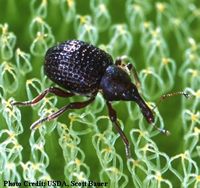
In an attempt to reduce the £400,000 a year cost of controlling the invasive water fern, Salvinia rotundifolia in Britain's lakes and canals, British Waterways is to introduce weevils. The South American weevil, Cyrtobagous salviniae, (Photo by USDA, Scott Bauer) has been used successfully in a number of countries, to control Salvinia species and it is hoped it will do the same in the UK. The larva is white in colour and about four millimetres long. It burrows through rhizomes and feeds voraciously on new buds, warping and stunting the plant until it eventually sinks.
Beneficial GM
Research in Holland has investigated people's perception of GM food when it delivers a clear health benefit. They used an apple that had been engineered to be hypoallergenic amongst consumers with a mild allergy to apples. The apple was sold on a pilot basis in one large Dutch supermarket chain, in organic food stores, and at several green grocers. They found that consumers who reported having an allergy to apples perceived the GM apple as being more beneficial than those who did not report an allergy. They concluded: 'Overall, traditional breeding was the preferred production strategy, although acceptance of genetic modification as a process did increase with increasing perceived personal benefit associated with products, in particular those which were 'medically-related', or perceived to reduce allergic reactions.' Environmental reactions were less positive, but the researchers said this appeared to be largely due to concern over pesticide use. More
Quote of the Month
'If you cannot measure it, you cannot manage it'.
Chartered Accountant, Richard Davies of Chavereys (The Fruit Grower, July 2010)
eEvents Calendar
Precision irrigation scheduling: Integration of new technologies
3 Sep 2010, UK Irrigation Association
HRI Wellesbourne, UK
International Advances in Plant Virology
5 - 7 Sep 2010, Association of Applied Biologists
Arnhem, the Netherlands
Spoga
5 - 7 Sep 2010, Koelnmesse
Cologne, Germany
Four Oaks Trade Show
7 - 8 Sep 2010
Lower Withington, Cheshire, UK
Delivering Food Security with Supply Chain Led Innovations
7 - 9 Sep 2010, Association of Applied Biologists
Egham, Surrey
Saltex
7 - 9 Sep 2010, Institute Of Groundsmanship
Windsor, UK
Abbotsbury Tropical Gardens and Michaud's Chilli, Sweet Pepper etc.
8 Sep 2010, Professional Horticulture Group South West
West Bexington, Dorset, UK
Food Security and Safety Symposium
13 - 15 Sep 2010, Society for Experimental Biology
Lancaster University, UK
British Science Festival
14 - 19 Sep 2010, British Science Association
Birmingham, UK
Green Roofs For A Changing Climate
15 - 16 Sep 2010, Construction Industry Research and Information Association
London, UK
GLEE
20 - 22 Sep 2010
NEC Birmingham, UK
Report Writing
20 Sep 2010, British Institute of Agricultural Consultants
Royal Agricultural College, Cirencester, UK
Tomato Conference
30 Sep 2010, British Tomato Growers Association
Coventry, UK
South West Growers
6 Oct 2010, South West Growers Group
Matford Centre, Exeter, UK
Planning Updates
7 Oct 2010, British Institute of Agricultural Consultants
Stoneleigh Park, Kenilworth, UK
Peat in Horticulture
11 Oct 2010, International Society for Horticultural Science
Amsterdam, The Netherlands
International Conference on Organic Greenhouse Horticulture
11-14 Oct 2010, International Society for Horticultural Science
Bleiswijk, The Netherlands
HortiFair
12 - 15 Oct 2010
RAI, Amsterdam, the Netherlands
World Emulsions Congress
12 - 14 Oct 2010,
Lyon, France
Cactus Pear and Cochineal
17 - 22 Oct 2010, International Society for Horticultural Science
Agadir, Morocco
National Fruit Show
20 - 21 Oct 2010, Marden Fruit Show Society
Detling, Kent UK
Workshop on Biological Control of Postharvest Diseases
25 - 28 Oct 2010, International Society for Horticultural Science
Leesburg, Virginia, USA
Crop World
1 - 3 Nov 2010, United Business Media and British Crop Protection Council
ExCel, London UK
Planning to Achieve/More from Less
2 Nov 2010, British Institute of Agricultural Consultants
Kenilworth, UK
Predicting and Controlling the Shelf-Life of Foods
3 - 4 Nov 2010, Food Chain CIC
Leatherhead, Surrey, UK
Know Your Plants - Developing skills for better science, horticulture and communication
3 - 5 Nov 2010, Botanic Gardens Education Network
Royal Botanic Gardens, Edinburgh, UK
Advances in Biological Control
17 Nov 2010, Association of Applied Biologists
Marston, Lincs, UK
Towards 2013. An agriculture fit for purpose
17 - 18 Nov 2010, British Institute of Agricultural Consultants
Wellesbourne, Warwick, UK
Bananas, Genetics and Appropriate Biotechnology
18 Nov 2010, Society of Biology
Nottingham, UK
Tropical Horticulture
22 - 26 Nov 2010, International Society for Horticultural Science
Kingston, Jamaica
Oatridge Conference and Exhibition
25 Nov 2010, Scotgrow
Ecclesmachan, Nr Edinburgh, UK
Innovative ideas in pest and weed control in field vegetables
25 Nov 2010, Association of Applied Biologists
Rothamsted Research, Harpenden, UK
What makes an alien invasive?
7 - 8 Nov 2010, Association of Applied Biologists
Edinburgh, UK
Ideotypes - is the understanding of physiology relevant to the future of plant breeding?
7 Dec 2010, Association of Applied Biologists
Reading, UK
Water and nitrogen use efficiency in plants and crops
15 -16 Dec 2010, Association of Applied Biologists
Grantham,UK
Stress Responses – molecules, organisms, environments
4 - 7 Jan 2011, British Ecological Society, Society for Experimental Biology, Biochemical Society
London, UK
Interaction of Pesticide Application and Formulation on Residues in Fruit and Vegetables
9 Feb 2011, Association of Applied Biologists
Jealotts Hill, UK
- If you would like to advertise a forthcoming event, please contact communications@soci.org.
Horticulture Group Contact Details
For submitting ideas or to volunteer to be part of a committee or a group, please contact:
Acting Chairman - Peter Grimbly
Meetings Secretary - Marion Stainton
Minutes Secretary - Margaret Waddy
Newsletter co-ordinator - Sue Grimbly, E: scihortigroup@btinternet.com
SCI contact - communications@soci.org T: +44(0)20 7598 1500
